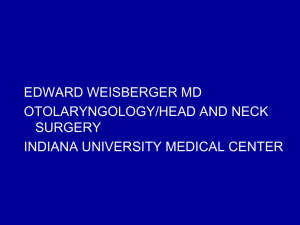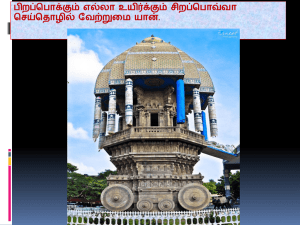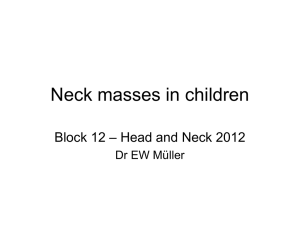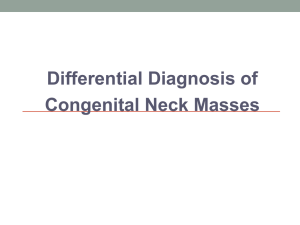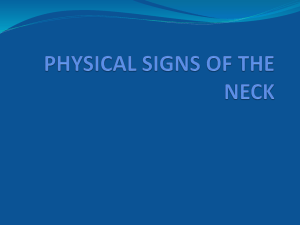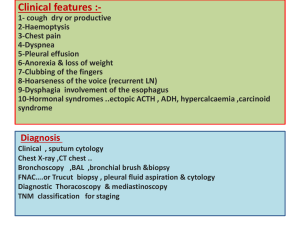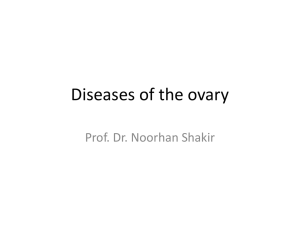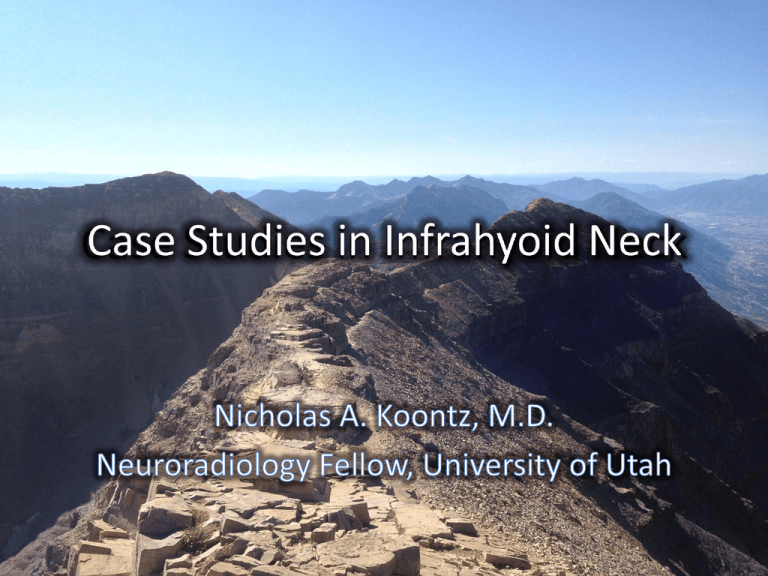
Financial Disclosures
But first…
• Please direct your smart phone, tablet, or
laptop’s browser to:
Objectives
• Review Infrahyoid Neck Anatomy
– Deep Spaces
– Nodal Stations
• Cases, Cases, Cases
– Tackle challenging cases
– Develop an appropriate differential diagnosis
– Identify useful discriminators
• Multiple choice questions
Anatomy
Anatomic Spaces of Infrahyoid Neck
Carotid
Space
Visceral Space
Retropharyngeal
Space
Perivertebral
Space
Posterior
Cervical Space
Infrahyoid Lymph Node Stations
Cases
Case 1
• 65 year-old woman with neck pain, palpable
lump
Differential
Diagnosis
• Differentiated Thyroid Ca
• Medullary Thyroid Ca
• Anaplastic Thyroid Ca
• Thyroid NHL
• Multinodular Goiter
Most Likely
Diagnosis
• Differentiated Thyroid Ca (DTCa)
•
•
•
•
•
•
Age & Sex
Ill-defined
Infiltrating, invasive
Mixed solid/cystic
Intra-thyroidal
Calcs
• Intra-thyroidal
• Intra-nodal
• Adenopathy
• Some solid
• Some cystic
• Punctate calcs
Question 1
• Which of the following is a TRUE statement?
– A. Follicular is the most common subtype of DTCa
– B. Hematogenous spread is more commonly
associated with Papillary carcinoma
– C. The peak incidence of DTCa is seen in women
in the third or fourth decade
– D. Rising free T4 is a clinical marker for disease
recurrence
Question 1
• Which of the following is a TRUE statement?
– A. Follicular is the most common subtype of DTCa
– B. Hematogenous spread is more commonly
associated with Papillary carcinoma
– C. The peak incidence of DTCa is seen in women
in the third or fourth decade
– D. Rising free T4 is a clinical marker for disease
recurrence
DTCa Companion Cases
1) 75 year-old-woman, neck lump
2) 48 year-old-woman, enlarging mass
3) Nodal Manifestations of DTCa
4) 30 year-old-woman, adenoma
Magnified Cor CECT of LN
Case 2
• 55 year-old-woman with right neck mass,
cough
Differential
Diagnosis
• H&N SCCa Metastatic Nodes
• Systemic Nodal Metastases
• Thyroid Ca Metastatic Nodes
• HL or NHL Nodes
• Granulomatous Lymph Nodes
• Reactive Adenopathy
Most Likely
Diagnosis
• Systemic Nodal Mets
• Infrahyoid (level IV) location
• H&N primary SCCa more
commonly levels II & III
• Non-calcified
• Sarcoid, DTCa often Ca++
• Central low-density/necrosis
• HL, NHL, & reactive nodes usually
solid, but can be low-density
Use Everything at Your Disposal
“I’ll tell you right now
– that ain’t normal.”
-- Rick Wiggins
Question 2
• Which of the following is MOST suggestive of
systemic nodal metastases in the neck?
– A.
– B.
– C.
– D.
Enlarged suprahyoid (level I or II) node
Enlarged left supraclavicular lymph node
Centrally necrotic lymph node
Calcification within an enlarged cervical node
Question 2
• Which of the following is MOST suggestive of
systemic nodal metastases in the neck?
– A.
– B.
– C.
– D.
Enlarged suprahyoid (level I or II) node
Enlarged left supraclavicular lymph node
Centrally necrotic lymph node
Calcification within an enlarged cervical node
Companion Case
25-year-old man with neck mass
HL with
“Signal” Node
• AKA Virchow node
• Isolated left supraclavicular adenopathy
look to the chest & abdomen for primary
• Most HL patients present with neck nodes
• Concurrent mediastinal nodes common
• Rarely extranodal H&N disease
• M>F
• Peak incidence in mid-20s
Question 3
• Which of the following is a TRUE statement?
– A.
– B.
– C.
– D.
HL is more common than NHL
Extranodal disease favors HL over NHL
Imaging can reliably differentiate NHL from HL
HL has an earlier peak incidence than NHL
Question 3
• Which of the following is a TRUE statement?
– A.
– B.
– C.
– D.
HL is more common than NHL
Extranodal disease favors HL over NHL
Imaging can reliably differentiate NHL from HL
HL has an earlier peak incidence than NHL
Case 4
• 55-year-old woman with known thyroid
nodules, reportedly benign – surveillance US
Longitudinal
Transverse
Power Doppler
Prior biopsy
reported benign
Differential
Diagnosis
• Congenital lesion
•
•
•
•
Lymphatic malformation
Venolymphatic malformation
Venous malformation
3rd Branchial cleft cyst
• Neurofibroma
• Schwannoma
• Malignant Lymph node
• Carotid artery Pseudoaneurysm
Most Likely
Diagnosis
• Congenital lesion
• Lymphatic malformation
• Benign, circumscribed
• No flow on US
• Demonstrably separate
from IJV and CCA
• Venolymphatic
malformation
• Possible, but would have
essentially no venous
component
• Why not a NST?
Carotid Space Nerve Sheath Tumor
Pros
•
•
•
•
Location
Size
Morphology
Low Density
Image c/o Lauren Ladd, M.D.
Cons
• Echogenicity
• Lack of vascularity
CS Nerve Sheath Tumor Comparison
Shape
CS Schwannoma
CS Neurofibroma
Fusiform
Ovoid or fusiform (***unless plexiform)
Margins Circumscribed
Circumscribed (***unless plexiform)
Size
2 - 8 cm
2 - 5 cm
M:F
Male predominance
Female Predominance
NECT
Isodense to muscle
Hypodense
CECT
Uniform enhancement, rare low density
Poorly enhancing
T1WI -C Variable, no flow voids
Isointense to muscle
T1WI +C Marked uniform enhancement
Homogeneous or patchy enhancement
T2WI
Very hyperintense, "target sign"
Hyperintense to muscle, +/- intratumoral cysts
Question 4
• Which of the following is a FALSE statement?
– A. Most lymphatic malformations are diagnosed
before age 2
– B. Lymphatic malformations can be acquired
– C. Lymphatic malformations have no malignant
potential
– D. Microcystic lymphatic malformations are less
likely to recur than macrocystic malformations
Question 4
• Which of the following is a FALSE statement?
– A. Most lymphatic malformations are diagnosed
before age 2
– B. Lymphatic malformations can be acquired
– C. Lymphatic malformations have no malignant
potential
– D. Microcystic lymphatic malformations are less
likely to recur than macrocystic malformations
Case 5
• 25-year-old man with enlarging neck mass,
recent URI
Same patient, 3 days prior
Differential
Diagnosis
• Thyroglossal Duct Cyst
• Lymphatic Malformation
• Mixed Laryngocele
• Necrotic Lymph Node
• Abscess
• Thyroid Ca
Most Likely
Diagnosis
• Infected Thyroglossal Duct Cyst
with associated FOM Abscess
• Classic history
• Midline/paramidline infrahyoid
• Wall enhancement infected
• Round or ovoid
• Cyst
• No calcs or solid component
Thyroglossal Duct Cyst
Key Points
• Cystic remnant of TGD
• Lesion of the young
• Location
•
•
•
20-25% = Suprahyoid
50% = Hyoid
25% = Infrahyoid
• Infrahyoid typically
embedded in strap
muscles “claw” sign
• Wall enhancement if
infected
• < 1% will develop
Thyroid Ca
Question 5
• Which of the following is a TRUE statement?
– A. Thyroglossal duct cyst is the most common
congenital neck mass
– B. Thyroglossal duct cysts are always midline
structures
– C. The most common malignancy to develop in a
thyroglossal duct cyst is medullary thyroid Ca
– D. Treatment of thyroglossal duct cyst is typically
needle aspiration
Question 5
• Which of the following is a TRUE statement?
– A. Thyroglossal duct cyst is the most common
congenital neck mass
– B. Thyroglossal duct cysts are always midline
structures
– C. The most common malignancy to develop in a
thyroglossal duct cyst is medullary thyroid Ca
– D. Treatment of thyroglossal duct cyst is typically
needle aspiration
TGD Cyst Companion Cases
1) 50-year-old man with neck mass
TGD Cyst. High density = heme, protein.
2) Young girl, dysphagia
TGD Cyst. Suprahyoid/BOT.
3) Enlarging neck mass
TGD Cyst Thyroid Ca. Enhancing nodule. Coarse calc. Nodal Met.
4) Ectopic Thyroid
Case 6
• 31-year-old woman with difficult intubation
during elective surgery
“I’ll tell you right now
– that ain’t normal.”
-- Rick Wiggins
Ax T1WI +C FS
Ax T1WI +C FS
Cor T1WI +C FS
Ax T2WI FS
Ax T2WI FS
Differential
Diagnosis
• NF1
• NF2
• Schwannomatosis
• Laryngeal SCCa with Mets
• Chondrosarcoma with Mets
Ax T2WI FS
Ax T1WI +C FS
Most Likely
Diagnosis
• Schwannomatosis
• Morphology & Margins
• SCCa infiltrative/invasive
• Distribution
• CS + Brachial plexus NST
• NORMAL IACs
• NF2 less likely
• Age
• NF1 = 1st decade
• NF2 = 2nd decade
• Schwannomatosis = 3-4th decades
• No matrix calcification
• MR signal NST
Question 6
• Which of the following is a TRUE statement?
– A. Schwannomas grow centrally within an
involved nerve
– B. Schwannomatosis patients demonstrate a
normal life expectancy
– C. Schwannomas arise from pericytes in the nerve
sheath
– D. Schwannomatosis is more common than NF1
Question 6
• Which of the following is a TRUE statement?
– A. Schwannomas grow centrally within an
involved nerve
– B. Schwannomatosis patients demonstrate a
normal life expectancy
– C. Schwannomas arise from pericytes in the nerve
sheath
– D. Schwannomatosis is more common than NF1
Schwannomatosis Key Points
• Multiple nonintradermal schwannomas
WITHOUT vestibular nerve involvement
• Separate disease entity from NF2
– Different gene mutation
• SMARCB1 vs. NF2
– Later onset
• 4th decade vs. 2nd decade
– Normal life expectancy (unlike NF2)
– Pain >> neurologic deficits (unlike NF2)
• Similar incidence to NF2 (~ 1/40,000)
Infrahyoid Neck Conclusion
• Several deep spaces & nodal stations
– Wide variety of pathology
• Look for useful discriminators:
– Age
– History
– Deep space of origin
Thanks
nick.koontz@hsc.utah.edu

